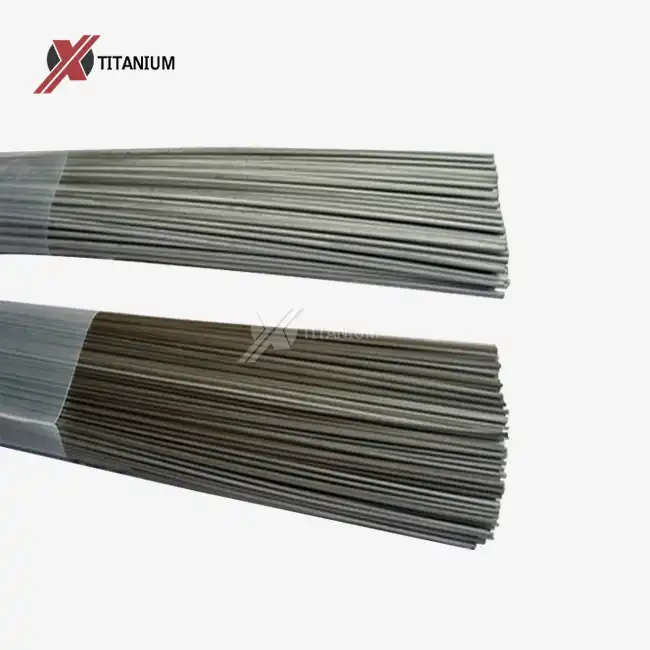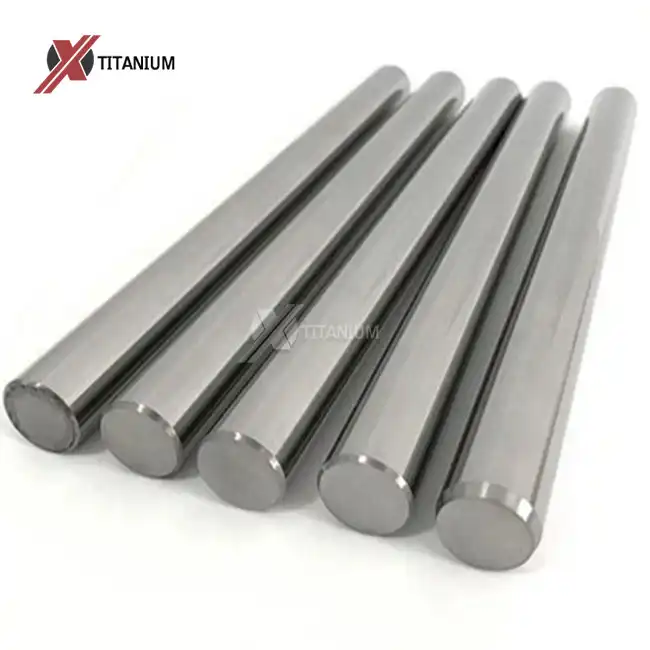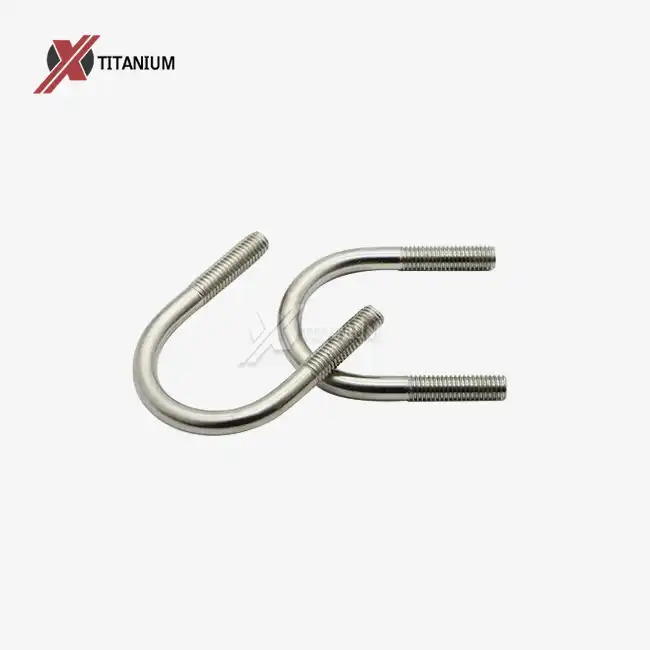Selecting the Right Titanium Welding Wire
Understanding Titanium Grades and Their Applications
Choosing the appropriate titanium welding wire is paramount to achieving optimal weld quality. Titanium alloys are categorized into different grades, each with unique properties suited for specific applications. Grade 1 and 2 titanium wires are commonly used for general-purpose welding, offering excellent corrosion resistance and moderate strength. Grade 5 (Ti-6Al-4V) is a popular choice for aerospace and medical applications due to its high strength-to-weight ratio and biocompatibility.
When selecting titanium welding wire, consider the base material's composition and the intended application. Matching the filler metal to the base material ensures chemical compatibility and consistent mechanical properties throughout the weld. For instance, when welding Grade 2 titanium plates, use Grade 2 titanium welding wire to maintain uniform corrosion resistance and strength.
Wire Diameter and Feed Rate Considerations
The diameter of titanium welding wire affects both the weld penetration and heat input. Smaller diameter wires (0.030 to 0.045 inches) are ideal for thin materials and intricate welds, offering better control and reduced heat input. Larger diameter wires (0.062 to 0.093 inches) are suitable for thicker materials and higher deposition rates.
Adjust the wire feed rate according to the chosen diameter and welding parameters. A faster feed rate increases deposition but requires higher heat input, while a slower feed rate allows for better control and reduced heat-affected zones. Experiment with different combinations to find the optimal balance between weld quality and productivity.
Preparation and Handling of Titanium Welding Wire
Cleanliness and Contamination Prevention
Titanium is highly reactive at elevated temperatures, making cleanliness crucial when working with titanium welding wire. Contaminants can lead to porosity, embrittlement, and reduced corrosion resistance in the weld. Before welding, clean the base material and filler wire thoroughly using a stainless steel brush or acetone to remove any oils, dirt, or oxides.
Store titanium welding wire in a clean, dry environment to prevent moisture absorption and oxidation. Consider using sealed containers or vacuum-packed spools to maintain wire integrity. When handling the wire, wear clean, lint-free gloves to avoid introducing contaminants from skin oils or other sources.
Proper Spooling and Feeding Techniques
Ensure smooth wire feeding by properly spooling the titanium welding wire onto the welding machine. Avoid kinks or twists in the wire, as these can lead to feeding issues and inconsistent weld quality. Use a wire straightener to remove any residual curvature from the spool, especially when working with larger diameter wires.
Maintain the correct tension on the wire feeder to prevent bird-nesting or excessive drag. Adjust the drive rolls to provide consistent feeding without deforming the soft titanium wire. Regular inspection and cleaning of the wire feed system help prevent contamination and ensure reliable performance.
Optimizing Welding Parameters for Titanium
Shielding Gas Selection and Flow Rates
Proper shielding is critical when welding titanium to prevent atmospheric contamination. Pure argon is the most commonly used shielding gas for titanium welding, providing excellent arc stability and weld pool protection. For specialized applications, mixtures of argon with small amounts of helium can enhance penetration and travel speed.
Set the shielding gas flow rate between 15 to 30 cubic feet per hour (CFH) for most titanium welding applications. Higher flow rates may be necessary for outdoor welding or when working with larger weld pools. Utilize trailing shields or purge boxes to extend gas coverage and protect the weld as it cools, preventing oxidation and maintaining mechanical properties.
Heat Input and Travel Speed Control
Controlling heat input is crucial when welding titanium to minimize distortion and prevent grain growth. Use pulsed welding techniques to reduce overall heat input while maintaining adequate penetration. Adjust the peak and background current levels to achieve the desired balance between penetration and heat-affected zone size, which is especially important for titanium welding wire OEM applications.
Maintain a consistent travel speed to ensure uniform weld bead appearance and penetration. Slower travel speeds increase heat input and weld penetration but may lead to excessive grain growth. Faster travel speeds reduce heat input but can result in lack of fusion or incomplete penetration. Find the optimal balance through experimentation and visual inspection of weld quality.
Conclusion
Mastering the art of welding with titanium wire requires a combination of proper material selection, meticulous preparation, and precise control of welding parameters. By understanding the unique properties of titanium and implementing the tips outlined in this guide, welders can consistently produce strong, clean welds that meet the demanding requirements of various industries. Remember that practice and experience play crucial roles in achieving optimal results, so don't hesitate to experiment and refine your techniques. With the right approach and attention to detail, you can unlock the full potential of titanium welding wire and create welds that stand the test of time.
At Baoji Chuanglian New Metal Material Co., Ltd., we specialize in providing high-quality titanium welding wire and OEM services to meet your specific project needs. Our extensive experience and commitment to excellence ensure that you receive the best materials for your welding applications. For more information about our titanium welding wire or to discuss your custom requirements, please contact us at info@cltifastener.com or djy6580@aliyun.com.
FAQ
What surface finishes are available for titanium welding wire?
Our titanium welding wire is available in various surface finishes, including bright, polished, pickled, acid cleaned, and sandblasted, to suit different welding requirements and applications.
What quality tests are performed on your titanium welding wire?
We conduct rigorous quality tests on our titanium welding wire, including hardness tests, bending tests, and hydrostatic tests, to ensure consistent performance and reliability.
What are the key features of your titanium welding wire?
Our titanium welding wire offers high corrosion resistance, low density, and excellent thermal stability, making it ideal for demanding applications in chemical processing, industrial manufacturing, and sports equipment production.
References
1. Smith, J. (2020). Advanced Techniques in Titanium Welding. Journal of Materials Engineering and Performance, 29(8), 5123-5135.
2. Johnson, A., & Brown, R. (2019). Optimizing Shielding Gas Parameters for Titanium TIG Welding. Welding Journal, 98(6), 183-192.
3. Li, X., et al. (2021). Effect of Wire Feed Rate on Microstructure and Mechanical Properties of Titanium Alloy Welds. Materials Science and Engineering: A, 812, 141082.
4. Garcia, M., & Thompson, S. (2018). Contamination Prevention Strategies in Titanium Welding. International Journal of Advanced Manufacturing Technology, 95(5), 2287-2298.
5. Wilson, D. (2022). Pulsed Arc Welding Techniques for Titanium Aerospace Components. Aerospace Science and Technology, 120, 107254.




